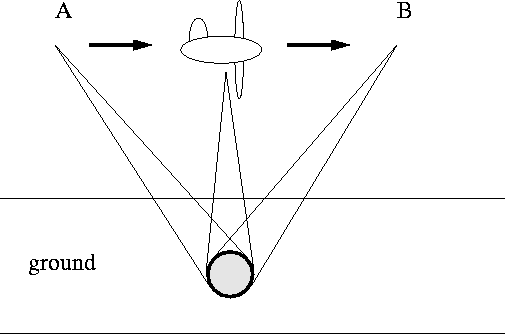
Synthetic aperture radar (SAR) is a technique for taking extremely high- resolution radar images, typically of ground features from an airplane. In spotlight mode, the radar beam is focused on one patch of ground as the aircraft flies from point A to point B. Returned signals are collected continuously to create a high-resolution image integrated over a very large aperture.

Several stages of this procedure can benefit from the power of parallel computing. I worked with several SAR experts at Sandia to implement their computational algorithms on large parallel machines we had at the time -- an nCUBE 2 and Connection Machine (CM-2). The SAR group at Sandia ended up purchasing their own 1024-processor nCUBE 2 for research and day-to-day data processing because of the increased throughput it provided.
Several stages of the SAR data processing are discussed in the papers below. The first is called "polar reformatting", which is to take a large dataset (e.g. 16384 x 65536) which has been collected on a polar grid (circular points in the figure) and accurately interpolate it to a Cartesian grid (square points). This operation is performed in reciprocal or phase space.
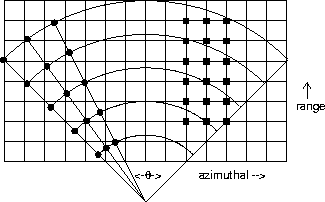
This picture illustrates the input to the polar reformatting algorithm and the result for a simple test pattern. When the polar data is displayed on a Cartesian grid, straight lines appear bent; the reformatting corrects for this effect.
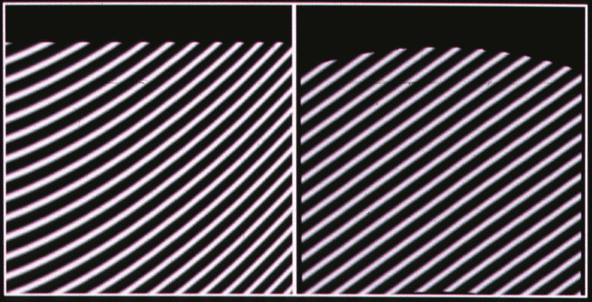
The next stage is to perform a very large 2-d FFT to convert the SAR data from phase space to real space. Our algorithmic work in parallel FFTs is discussed here. Basically it requires an all-to-all matrix transpose sandwiched between 2 sets of 1-d FFTs. The 4 GB aggregate memory of the nCUBE 2 (large at the time!) proved adequate for performing this entire operation in-memory.
Finally, the SAR image needs enhancement to correct for errors due to effects like airplane motion and platform jitter. We implemented a parallel version of the phase-gradient autofocus (PGA) algorithm invented by my collaborators at Sandia. PGA has the advantages of being automatic (requiring no user intervention), correcting phase errors of all orders, and working on high and low signal-to-clutter images. In our implementation PGA proceeds in 2 phases: first the correction factors are computed for a subpatch of the overall image, then the correction is applied repeatedly to all subpatches in the entire image. The effect can be dramatic as illustrated in this data set.
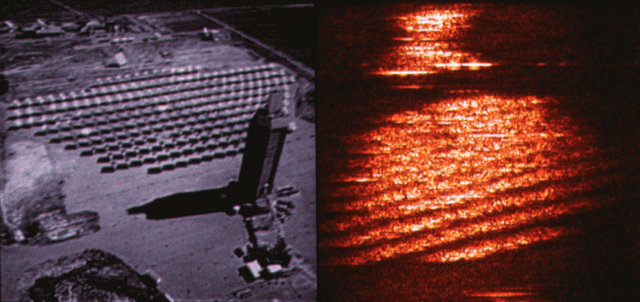
The photograph on the left is of a solar tower and mirror array at Sandia. The as-collected radar image of the tower is shown on the right. The images below are of the radar image after enhancement via the PGA algorithm. The left image is after a few iterations of PGA; the fully corrected image is on the right. Note that the radar shadow cast by the tower onto the array of mirrors is now clearly visible, as are the mirror corners and tie-downs (bright points). The latter are very small features that SAR is capable of resolving due to their sharp corners (high reflectivity).
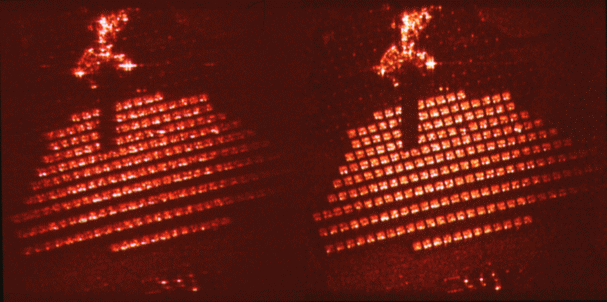
Collaborators on this project:
Details of the 3 stages of SAR data processing are described in these papers. Parallel performance and scalability are discussed for the nCUBE 2 and Connection Machine (CM-2) platforms.
A Massively-Parallel Digital Processor for Spotlight Synthetic-Aperture Radar, G. A. Mastin, S. J. Plimpton, D. Ghiglia, Int J of Supercomputer Applications, 7, 97-112 (1993). (abstract)
Synthetic Aperture Radar Image Processing on Parallel Supercomputers, S. J. Plimpton, G. A. Mastin, D. Ghiglia, in Proc of Supercomputing '91, Albuquerque, NM, November 1991, p 446. (abstract)